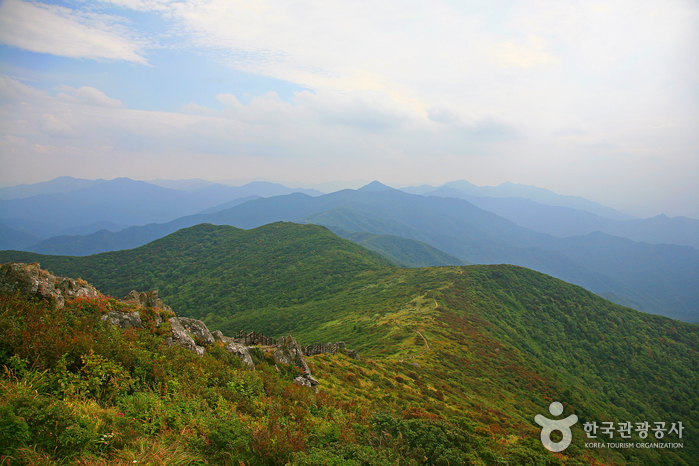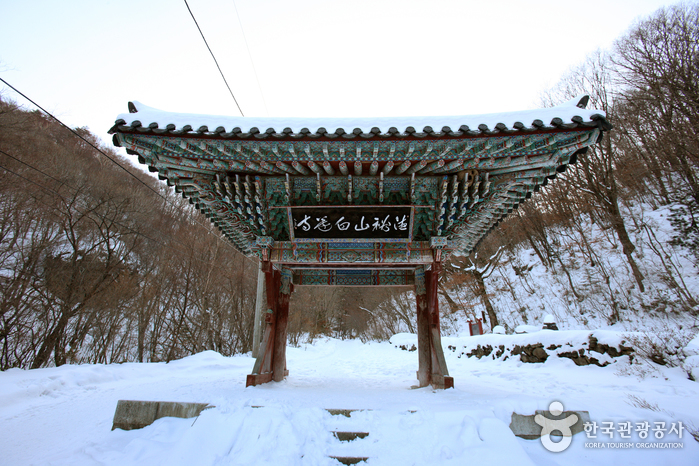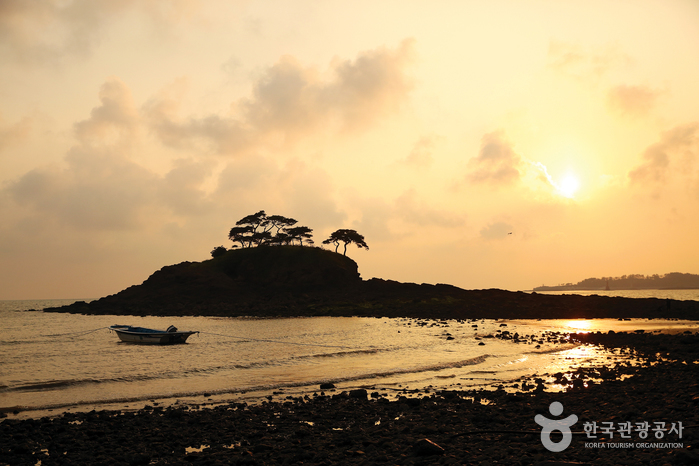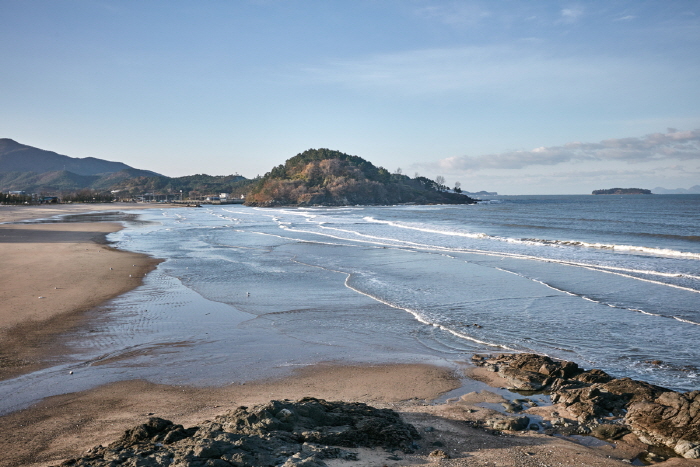Daehan Dawon Tea Plantation (대한다원)
2025-06-05
763-65, Nokcha-ro, Boseong-gun, Jeollanam-do
+82-61-852-4540
Daehan Dawon Tea Plantation produces high-quality green tea and is a popular tourist attraction year-round thanks to the vast rows of tea trees that line the hillside like a deep green carpet. Despite being located on a small peak at just 350 meters above sea level, the observation deck at the summit offers views of the sea on clear days. The entrance to the tea plantation is also lined with tall cedar trees, adding a unique aspect to this plantation. Daehan Dawon Tea Plantation has been featured as a filming site in dramas such as “Summer Scent (2002),” “Legend of the Blue Sea (2017),” and “The Rebel (2017).”
Deogyusan National Park (Main, Jeoksang Section) (덕유산국립공원 (본소,적상분소))
2024-04-07
159, Gucheondong 1-ro, Muju-gun, Jeonbuk-do
+82-63-322-3174
The area of Deogyusan National Park stretches out from the southern ridges of Sobaeksan Mountain, covering regions within four different counties in Gyeongsangnam-do and Jeollabuk-do. The park is nestled in Deogyusan Mountain, Korea's 4th tallest mountain with the summit reaching an elevation of 1,614 meters. The mountain is blessed with a 36-kilometer valley dotted with several scenic points, ponds, and waterfalls.
The mountain contains prestigious cultural heritages, such as Jeoksangsanseong Fortress (Historic Site No. 146) and the Hanging Painting of Anguksa Temple (Treasure No. 1267) to name a few. It is also home to diverse wildlife animals and plants. The mountain's beauty can be enjoyed all year round, with royal azaleas in spring, a colony of daylilies in summer, colorful autumn foliage in fall, and a white snowy mountain vista in winter.
Deogyusan Resort (무주덕유산리조트(구, 부영덕유산리조트))
2025-03-18
185, Manseon-ro, Seolcheon-myeon, Muju-gun, Jeonbuk-do
+82-63-322-9000
Deogyusan Resort (former Muju Resort) is located in Mt. Deogyusan, and is a representative mountain resort. It blends in beautifully with the scenery of Mt. Deogyusan National Park, and is the perfect place to enjoy winter sports.
<br>
<br>Deogyusan Resort is great place to relax all year round, with Alps-style first class hotel and a variety of convenience facilities in its 2,200,000 pyeong area. The resort is especially famous for its ski courses, and many enthusiasts come here during the winter. At Manseonbong Peak (1,215m) skiing grounds, there is a lift that can handle 13,000 people at once, and there are a variety of courses from beginners' to professional levels.
<br>
<br>Seolcheon Peak (1,520m) skiing ground where Asian Universiade competition officially opened, has a variety of gondolas and lifts, along
with a hot spring to relax after skiing. The outdoor hot springs with snow-covered mountains is especially famous.
<br>
<br>In addition to the aforementioned facilities, you can enjoy tennis, mountain climbing, MTB, and horse riding, and at the theme-based shopping mall, Carnival Street, there are interesting products to see and food to enjoy. You can buy famous brand products from all over the world here cheaply, so look around.
Muju Baengnyeonsa Temple (백련사(무주))
2024-04-07
580, Baengnyeonsa-gil, Muju-gun, Jeonbuk-do
+82-63-322-3395
Baengnyeonsa Temple is located in the upper part of Gucheondong Valley on Deogyusan Mountain. It is said that during the Silla Kingdom, a white lotus flower bloomed here, and that's why the temple is called Baengnyeonsa (lit. White Lotus Temple). The temple is the only remaining temple out of 14 that were built in the Gucheon-dong area of Muju. After walking over Baengnyeongyo Bridge at the entrance of the temple, you will come to a stone stairway. At the top is the main sanctuary. The majesty and beauty of the main sanctuary is well complemented by the mountains. The Mokjosamjonbul Stone Buddha within the main building is presumed to have been built in the latter half of the Joseon dynasty. Past Myeongbujeon is Baengnyeonsa’s Sajeokbi tombstone, and the workmanship of the carved calligraphy is very highly regarded.
Byeonsanbando National Park (변산반도국립공원)
2024-04-07
11, Bangpaje-gil, Byeonsan-myeon, Buan-gun, Jeonbuk-do
+82+63-582-7808
Designated as a national park in 1988, Byeonsanbando National Park is the only national park in the country that consists of both the ocean and the mountains. The park is divided into two large sections: the shore area, called Outer Byeonsan, and an inland area called Inner Byeonsan. It has mountain peaks made up of unique rock formation, such as Uisanbong Peak (508 meters), Chaeseokgang Cliff, and Jeokbyeokgang Cliffs. Nearby Gyeokpo Port and Naesosa Temple are all worth exploring, enriching the experience of the area. It's also well known for having the latest sunset in the country with stunning panoramic views.
Byeonsan Beach (변산해수욕장)
2025-01-15
2076 Byeonsan-ro, Buan-gun, Jeonbuk-do
+82-63-583-6951
Byeonsan Beach is a representative beach of the west coast. The beach is known for its white sand and fir trees. Also, having opened in 1933, it is the oldest beach in Korea. The fine sandy beach stretches endlessly and the water is clear. Furthermore, the water is only 1 meter deep and warm, making it an ideal beach for playing in the water.
Wolchulsan National Park (월출산국립공원)
2024-01-10
280-43 Cheonhwangsa-ro, Yeongam-eup, Yeongam-gun, Jeollanam-do
Wolchulsan Mountain, which means "moon rising mountain," is a national park in the southernmost part of Korea with beautiful nature. The mountain towering around Cheonhwangbong Peak at 810.7 meters above sea level stands out even more due to the flat land around it. The unique rock formations look differently depending on the angle, as a human face or animal shape, exuding overwhelming grandeur. More than 700 plant species and 800 animal species inhabit the area, and a subtropical forest and a warm-temperate forest coexist, making it very valuable to preserve. The ridge from the Cheonhwangsa Temple site or Baramgyegok Valley to Cheonhwangbong Peak, Gujeongbong Peak, and Dogapsa Temple is the main trail, which takes about six hours. The course’s most exciting point is the 120-meter high and 54-meter long red suspension bridge that offers a picturesque view of Wolchulsan Mountain and the fields and paddies under the mountain.
Naejangsan National Park (내장산국립공원)
2025-01-17
328 Naejanghoban-ro, Jeongeup-si, Jeonbuk-do
Naejangsan Mountain is a famous mountain in Jeonbuk-do, and the best mountain in Korea to view the fall foliage. Because of the bright autumn leaves that blanket Naejangsan Mountain in fall, the mountain is also referred to as Geumgang of Honam, referencing the beautiful Geumgangsan Mountain.
Inside the park, there are famous waterfalls, such as Dodeokpokpo Falls and Geumseonpokpo Falls, and temples such as Baegyangsa Temple and Naejangsa Temple. In addition, there are about 760 kinds of local plants, including those designated as Natural Monuments, and various wild animals living inside the park.
Naejangsan National Park is beautiful not only in fall, but also in spring when the azaleas and cherry blossoms bloom, in summer when the mountain turns green, and winter when the rock cliffs are covered with snow.
Dadohaehaesang National Park (Wando Section) (다도해해상국립공원(완도))
2024-04-04
Wando-eup, Wando-gun, Jeollanam-do
+82-61-550-0900
Dadohaehaesang National Park was established on December 23, 1981 as the 14th national park, and it is the nation's largest park, spread over 2,344 ㎢. Within this area are nearly 1,700 islands of varying sizes, including Hongdo, Heuksando, Geomundo, and Baekdo Islands. During the Silla period, the King of the Sea, Jang Bogo established the maritime world and during the Goryeo dynasty, the area was a trading path with the Yuan and Song dynasties. Also, it was the battlefield where Admiral Yi Sun-sin defeated the invading navy during the Imjin War (1592-1598). Likewise, historical sites remain in many places.
Maisan Provincial Park (마이산도립공원)
2024-04-07
126-3, Danyang-ri, Jinan-eup, Jinan-gun, Jeonbuk-do
+82-63-430-8751
Maisan Provincial Park is a rocky mountain composed of two great peaks, Ammaibong (687.4 meters) and Sumaibong (681.1 meters), and dozens of smaller peaks. These peaks have a variety of names depending on the season. In spring, the mountain provides sweeping panoramic views for its cherry blossoms, and cosmos and silver grass in fall. The Eunsusa Temple, Geumdangsa Temple, and Tapsa Temple with its 80 stone pagodas are all worth exploring, enhancing the experience of the area.







 English
English
 한국어
한국어 日本語
日本語 中文(简体)
中文(简体) Deutsch
Deutsch Français
Français Español
Español Русский
Русский